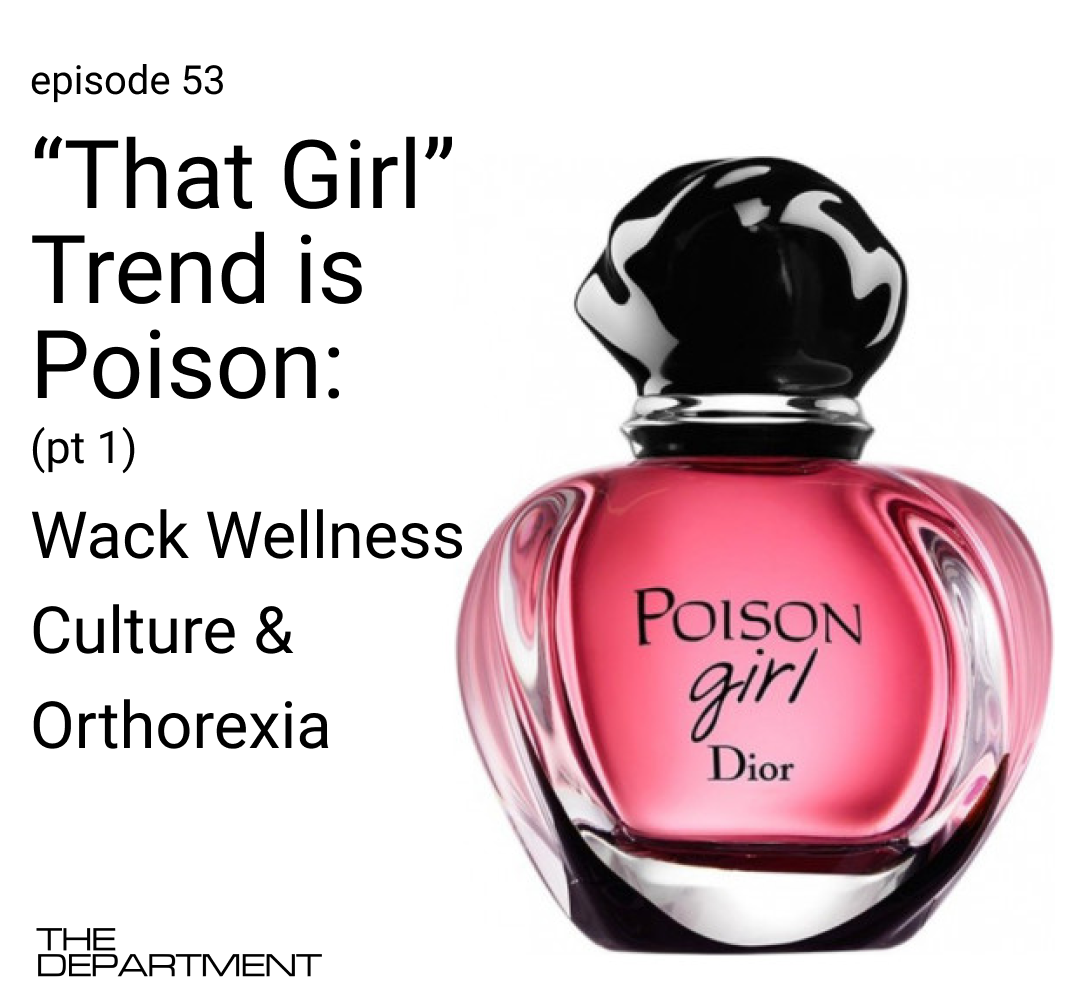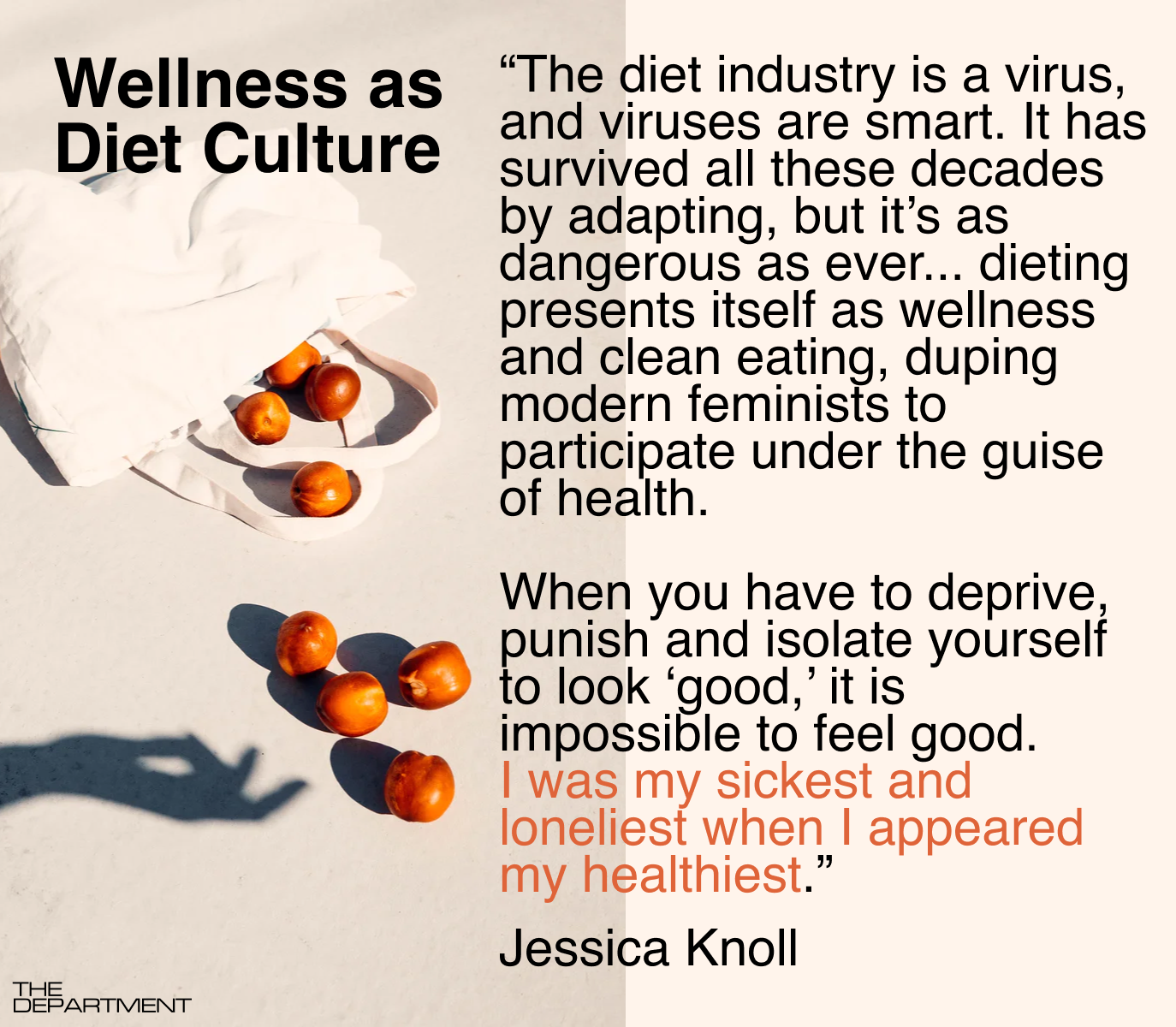︎︎︎episode 53
“That Girl” Trend is Poison: Wack Wellness Culture & Orthorexia
Aug 17th, 2021
︎︎︎︎ Listen on Apple
︎︎︎︎ Listen of Spotify
︎︎︎︎ Listen on Stitcher

TW: this episode does discuss eating disorders and social media phenomena related to eating disorders.
If you or someone you love is dealing with an eating disorder, please visit The National Eating Disorders Association (NEDA). They provide free and low cost support for individuals with eating disorders.
So this week a trend bubbled up in my inbox by someone who i work with and I was shocked I hadn’t caught wind of it earlier - granted I am so insanely busy I haven’t been keeping my ear to the ground as closely. And as to Amanda’s points earlier - if you see something (well a trend) say something!
Essentially there is a # trend on Tiktok that is showing up creating another rather controversial movement. And well, this isn’t a new movement, this is some toxic trends bubbling back up and disguised as an Aesthetic - sweeping a new community of young women. The GenZ. It is like there must be some iteration of this for every generation.
So to break down the trend - “That Girl” or #thatgirl fetishizes the aesthetic of a holistic aspirational social media trope - and much like Girlboss and wellness culture it is whitewashed with privilege. I would liken it to GenZ’s Aesthetic second wave of a Moonjuicificed, Goopified lifestyle. It comes on the heels of the health, wellness and mindfulness trend that we know has just BLOWN UP during the pandemic.
That girl is the perfection of self-achievement in a holistic personal wellness and physicalality- she has been put on a pedestal as the ultimate “role-model” - yet she is not even a real person and exists almost exclusively in a world of toxic tropes.
She gets up at 5am, works out, drinks green juice, writes down her goals, makes her bed - she is the perfection of efficiency and optimization. That girl - is someone to be admired to the point of invoking low-key jealousy- That girl is the girl you see on your feed or in a magazine who has her shit just really together - has it all and then some with gold stars all around for self-improvement, wellness, goal setting and physical fitness. In a more visual sense : A slim hipped, Blond Pony, Green Juice sipping, post workout glowing, journal wielding model of perfection all dressed up in Lululemons.
There are tiktoks devoted to this aesthetic - always very minimal and clean like a real, live moving pinterest board to particularly entice the viewer and capturing their audience with the beauty of how this lifestyle and the aspiration that has been drilled into culture for years- on either how to achieve the lifestyle or people living it and broadcasting it.
Of course as an outsider looking in we can see the red flags - we recognize a lot of the toxic attitudes and I am surprised, yet NOT surprised that this is just a new iteration of an age old form of very outdated societal constructs rooted in traditional ideals of femininity. It is a venn diagram with Hustle Culture, Wellness and Self-care all intersecting at a point of being unrealistic - and in fact dangerous in some cases.

“That Girl” essentially is a social construct that through our joint consumption of media and social media as a culture is pretty easy for anyone to picture and has a bit of a universal visual comprehension. Well the “that girl” trend grabs onto the self-improvement trend and mirrors these girls you see and want to emulate- applied then in your own life as you continually and increasingly “optimize”. So a video of you drinking a green juice in the morning and calling yourself “that girl” - a perpetual attempt to climb the mount everest that is perfection….yet wellness isn’t a result but a constant process. Not something that a certain type of person once or finishes or perfects or achieves as wellness is turned into an ideology….There are hundreds of books and diets on how to loose weight - but only a few on WHY because our approach to health and wellness is about the Aesthetics and not as much about the scientific reasoning.
So this “that girl” trend is all based on mainstream notions of the ideology of wellness with no real end goal. It just is a lifestyle - a mimicing of something that is considered optimizing and superior. Eating a bowl of fruit in the morning, expensive skin care routines, yoga before the sun is even up…
I want to break this trend apart piece by piece and digest the elements. There are so many really stirring articles written by some really great people that I will of course be using.
- Eating Disorder/Body Image
- White Washing
- Over-Optimization
- Girl Boss and Toxic hustle/productivity culture
- Classism
Diet and Disordered Eating
So the first element I am going to tackle about this is the nutrition, diet and disordered eating part of the trend.
A big part of being “That Girl” revolves around elegant and minimal meals and juices like fruit bowls for breakfast, that post workout green smoothie, acai, zucchini ribbons, salads - all what is considered pure, whole and healthy. Critics of course have noticed that this is not a sustainable way of eating and have challenged these superior diet habits. The girls following the trend showcase what they ate for the day and of course - it aligns with extreme dieting and consuming below 1200 calories.
It reinforces the idea that “healthy” and a “healthy body” is able-bodied, thin, white, heterosexual and cisgender.
RUCHIRA SHARMA wrote a poignant article for Refinery 29 in July of 2021 that tackled this part of the equation - titled Who Is ‘That Girl’ & Why Is TikTok Obsessed With Her? And through her own research for the article herself reported multiple posts on TikTok that encouraged disordered eating . She even spoke to several proponents of the trend that have admitted that it lead to their own eating disorders.
Of course - as we mentioned - this is not a new trend by a longshot - this concept of “pure eating” trended excessively in the late aughts and all the way through the last decade under various disguises - from health and wellness gurus to juice cleanses - celebrating aspirational and aesthetically pleasing (read social media friendly) clean foods with the intention of maintaining or obtaining the ideal skinny and lean body has been at epidemic proportions for years.
I mean remember the Juice Cleanse trend - like 2010-2012 it was like the be all and end all? It was all about detoxifying the body - when in fact your body detoxifies itself everyday…..I never did it because I couldn’t afford it.
Sharma introduces the disordered eating that came out of this - called Orthorexia - which is essentially an unhealthy obsession with eating ‘pure’ foods. It was a clinical term coined in 1998 and is an anxiety and OCD style obsession around avoiding “bad foods” and of course it has been on the rise - in tandem with the wellness craze. Orthorexia has been continuously instigated by online social trends, destroying healthy relationships with food under the guise of being healthy while they are promoted by influential online wellness gurus spreading the word like wildfire. Dr. Stephanie Baker a senior lecturer in sociology at City University and an expert in online wellness has researched this industry for almost a decade. She says that in particular the attention to the visual beauty in “That Girl” there is "a sense of controlling your intake of food through the aesthetic meal," i.e. a meal that is neat and attractive but prioritises nutrition and aesthetic over taste. The prevalence of orthorexia has increased in recent years, likely in connection with the rise of social media. A recent study found that 49% of study participants who followed healthy eating accounts on Instagram met criteria for orthorexia.

The article goes on to reference a 2016 piece by food writer Ruby Tandoh for Vice called The Unhealthy Truth behind “wellness” and “clean eating” which is a fascinating look into the culture even 5 years ago that embraced this aspirational style diet. In it she considers the language used by clean eating influencers that she calls a toxic “purity fetish” - which comes with a moral assumption about how you live your life with an all or nothing attitude. Bringing shame and rejection when you “fall off the wagon” or “mess-up” which naturally reinforces the disordered eating even more. Tandoh interviews Nigella Lawson who is a proponent of having a healthy relationship with food who says : "I despair of the term 'clean eating, though I actually like the food that comes under that banner. ['Clean eating'] necessarily implies that any other form of eating—and consequently the eater of it—is dirty or impure and thus bad, and it's not simply a way of shaming and persecuting others, but leads to that self-shaming and self-persecution that is forcibly detrimental to true healthy eating."

Tandoh goes on to describe her own eating disorder saying “Wellness doesn't cause eating disorders. But when we advocate, and even insist upon, a diet so restrictive, moralizing, and inflexible, and market that diet to young women, and then dress it up as self-care: Just how responsible is that? When I subscribed to wellness, it gave me the means to rationalize my food insecurities, while glossing over my fear of food with the respectable veneer of health-consciousness. My illness was hidden in plain sight, and what's more—it became something to be proud of.”


Neil brought up this influencer that clearly went through a crisis in 2019 named Lee Tilhman - who had over 350K followers on your instagram @leefromamerica who promoted elaborate “wellness” routines and was aspirational to many. Neil remembers her almost OCD like plant watering situation which entailed taking all over her like 50 plants into a bathtub and washing them off like twice a week. Which equated to a part time job in itself. Back in 2019 she took a break - for like 6 months as worked to recoup from an eating disorder that was - that same thing - hidden in plain site and actually celebrated - as her focus on wellness was actually an unhealthy obsession of controlling her weight - with admitting to suffer from orthorexia. She has since pivoted from the extreme wellness diet and nutrition obsession into much more neutral content.
So “that girl” when applied in reality has just re-introduced the the same obsession and glorification of pure eating - with the added visuals of the ideal skinny body with the aspirational goals that in order to truly be “that girl” working out and eating in this particular way is the only option to attain the physical perfection that she exists in - feeding right back into fatfobia and an unhealthy relationship to diet and exercise.


